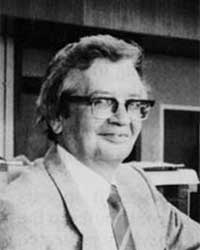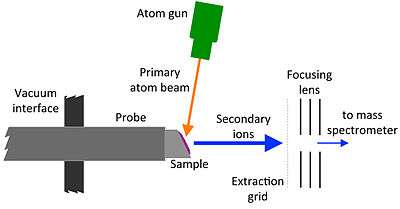Michael Barber (chemist)
Michael Barber (3 November 1934 – 8 May 1991) was a British chemist and mass spectrometrist best known for his invention of fast atom bombardment ionization.[1][2]
Michael Barber | |
|---|---|
 | |
| Born | 3 November 1934 Manchester, England, United Kingdom |
| Died | 8 May 1991 (aged 56) |
| Nationality | British |
| Alma mater | Queen's College, Oxford |
| Known for | Fast atom bombardment |
| Scientific career | |
| Fields | Chemistry, mass spectrometry |
| Doctoral advisor | John Wilfrid Linnett |
Career
Barber was born just outside Manchester on 3 November 1934 and from Manchester Grammar School went to Queen's College, Oxford to study chemistry. He remained at Oxford for his PhD, which involved the design of a mass spectrometer under the supervision of John Wilfrid Linnett. In 1961 he returned to Manchester to work at the Scientific Instruments division of Associated Electrical Industries. In 1973 he took up a lectureship position at UMIST and was promoted to Professor in 1985, he remained at Manchester until his death.[3]
The Michael Barber Centre for Collaborative Mass Spectrometry, based at Manchester University, is named in honour of him.
Fast atom bombardment

Fast atom bombardment (FAB) is a method of ionization used in mass spectrometry that uses a beam of high energy atoms strikes a surface to create ions.[4][5][6] An energetic beam of atoms or ions will destroy an organic molecule under conditions typically used to create secondary ions. Barber realised that mixing the compound of interest with a vacuum compatible low-volatility liquid such as glycerol effectively protected the organic molecule and allowed it to be ionized and detected.[2][7] The protecting liquid "matrix" allowed compounds as large as 10,000 Da molecular mass to be detected. The concept of a protecting matrix was later used in matrix-assisted laser desorption ionization.[8] The FAB technique was employed by Barber, Howard Morris (biochemist) and co-workers for early peptide sequencing experiments.[4]
Awards and honours
- Royal Society of Chemistry Award for analytical chemistry and instrumentation (1979)
- Fellow of the Royal Society (1985)
- American Society for Mass Spectrometry – The Distinguished Contribution in Mass Spectrometry Award (1991)
References
- Ronald Reid (12 November 1999). Peptide and Protein Drug Analysis. CRC Press. pp. 529–. ISBN 978-1-4200-0133-4.
- Green, Brian N. (1992). "In Memory: Professor Michael Barber FRS". Organic Mass Spectrometry. 27 (1): 67–67. doi:10.1002/oms.1210270119. ISSN 0030-493X.
- "Professor Michael Barber FRS. Born 3 November 1934; died 8 May 1991". Rapid Communications in Mass Spectrometry. 5 (7): 340–342. 1991. Bibcode:1991RCMS....5..340.. doi:10.1002/rcm.1290050709. ISSN 0951-4198. PMID 1841652.
- Morris HR, Panico M, Barber M, Bordoli RS, Sedgwick RD, Tyler A (1981). "Fast atom bombardment: a new mass spectrometric method for peptide sequence analysis". Biochem. Biophys. Res. Commun. 101 (2): 623–31. doi:10.1016/0006-291X(81)91304-8. PMID 7306100.
- Barber, Michael; Bordoli, Robert S.; Elliott, Gerard J.; Sedgwick, R. Donald; Tyler, Andrew N. (1982). "Fast Atom Bombardment Mass Spectrometry". Analytical Chemistry. 54 (4): 645A–657A. doi:10.1021/ac00241a817. ISSN 0003-2700.
- Barber M, Bordoli RS, Sedgewick RD, Tyler AN (1981). "Fast atom bombardment of solids (F.A.B.): a new ion source for mass spectrometry". Journal of the Chemical Society, Chemical Communications (7): 325–7. doi:10.1039/C39810000325.
- Gaskel, Simon J.; Gale, P. Jane (4 December 2015). Richard M. Caprioli (ed.). The Encyclopedia of Mass Spectrometry: Volume 9: Historical Perspectives, Part A: The Development of Mass Spectrometry. Michael L. Gross. Elsevier. pp. 11–12. ISBN 978-0-08-091325-4.
- Hillenkamp, Franz; Karas, Michael; Beavis, Ronald C.; Chait, Brian T. (1991). "Matrix-assisted laser desorption/ionization mass spectrometry of biopolymers". Analytical Chemistry. 63 (24): 1193A–1203A. doi:10.1021/ac00024a716. ISSN 0003-2700. PMID 1789447.
External links
- Barber, Michael; Bordoli, Robert S.; Sedgwick, R. Donald; Tyler, Andrew N. (1981). "Fast atom bombardment of solids (F.A.B.): a new ion source for mass spectrometry". Journal of the Chemical Society, Chemical Communications (7): 325. doi:10.1039/c39810000325. ISSN 0022-4936.
- Michael Barber Centre, University of Manchester